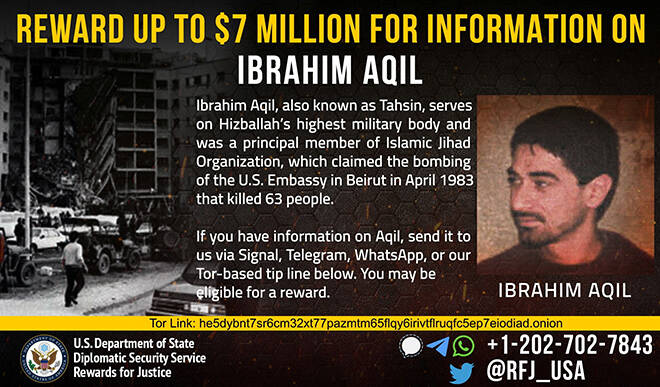Hezbollah leader killed by Israel was wanted in 1983 bombings of U.S. embassy, Marine barracks

U.S. STATE DEPT. via REUTERS
An undated photograph of Ibrahim Aqil, who served on Hezbollah’s top military body as a senior commander according to sources, appears on a wanted poster circulated by the U.S. Department of State’s Diplomatic Security Service entity “Rewards for Justice.” Israel said he was among those killed in its airstrike in Beirut today.
TEL AVIV, Israel >> Israeli fighter jets bombed an apartment building in Beirut’s densely populated southern suburbs today in what the military called an attack on Hezbollah militants, including a senior commander who was wanted in the deadly 1983 bombings of the U.S. Embassy and U.S. Marine Corps barracks in Beirut.
The Israeli military’s chief spokesperson, Rear Adm. Daniel Hagari, said the senior commander, Ibrahim Akil, had been killed, along with “around” 10 others from Hezbollah’s elite Radwan unit.
Hezbollah, the powerful Lebanese militia backed by Iran, confirmed that Akil had been killed.
The United States has accused Ibrahim Akil of playing a key role in the bombing of the U.S. Embassy in Beirut in April 1983, which killed 63 people, and the bombing of the U.S. Marine barracks in Beirut in October 1983, which killed more than 300 people, including 241 U.S. military personnel.
Last year, the State Department posted a reward of up to $7 million for information leading to his capture.
Israel said Akil was the head of Hezbollah’s military operations directorate and the de facto commander of the Radwan unit, which has taken a lead role in the rocket and drone attacks on northern Israel.
Don't miss out on what's happening!
Stay in touch with breaking news, as it happens, conveniently in your email inbox. It's FREE!
Today’s strike Opens in a new tab fueled fears that Israel is driving closer to a full-blown war with Hezbollah, even as it continues to fight Hamas in the Gaza Strip.
The strike today came as Lebanon was still reeling from the attacks Tuesday Opens in a new tab and Wednesday Opens in a new tab — widely attributed to Israel — that blew up communication devices belonging to Hezbollah members, killing at least 37 people and injuring thousands, Lebanese health officials said. Hezbollah’s leader vowed Thursday to retaliate against Israel for those blasts, but did not describe how or when.
As with Israeli airstrikes in Gaza, the one today in Lebanon led to destruction and death in a heavily residential area. Lebanese officials said that two apartment buildings had collapsed, killing at least 14 people and injuring more than 60 others, including children.
Hagari told reporters that Akil and other Hezbollah commanders had been meeting in the residential building in an attempt to “use civilians as human shields.” The New York Times could not independently verify that information.
Today, John Kirby, the White House National Security Council spokesperson, said the United States had “no involvement” in the strike and was working to avoid an escalation of the crisis along the Lebanon-Israel border.
“We still believe that there is time and space for a diplomatic solution,” Kirby told reporters.
———
This article originally appeared in The New York Times.
© 2024 The New York Times Company





